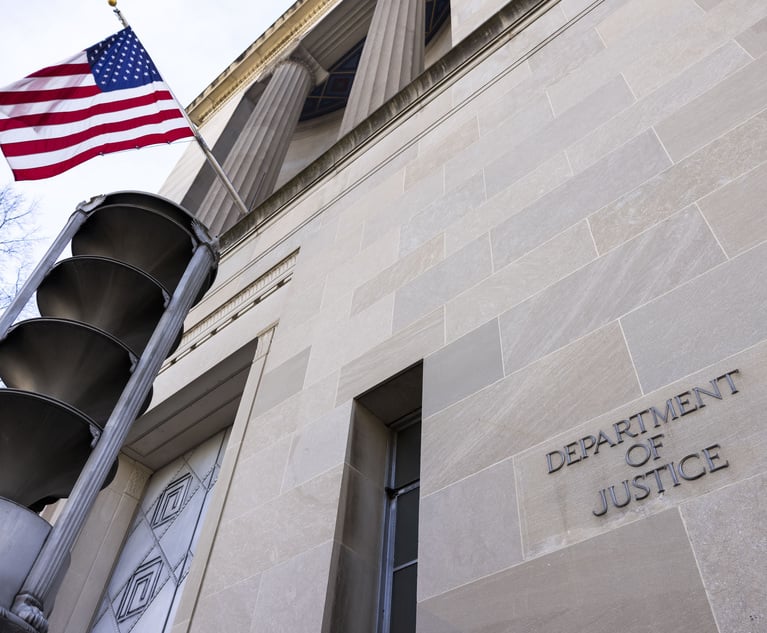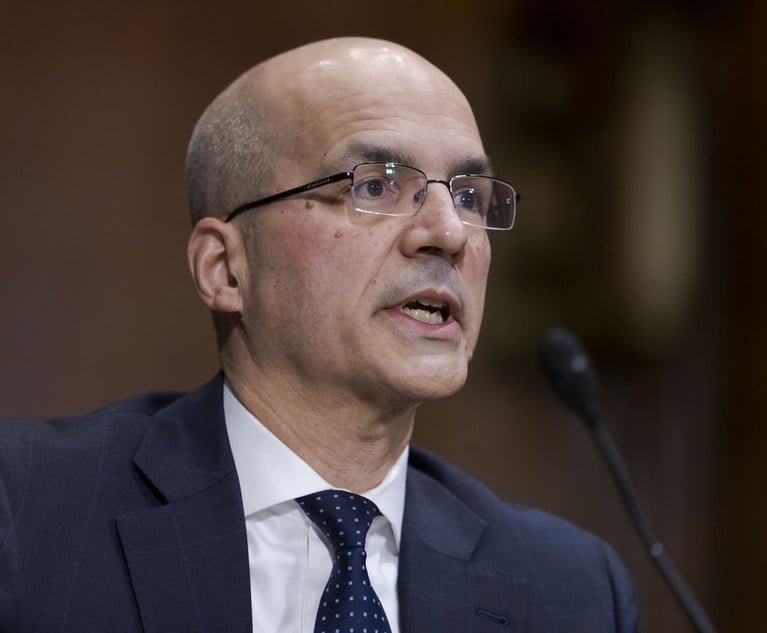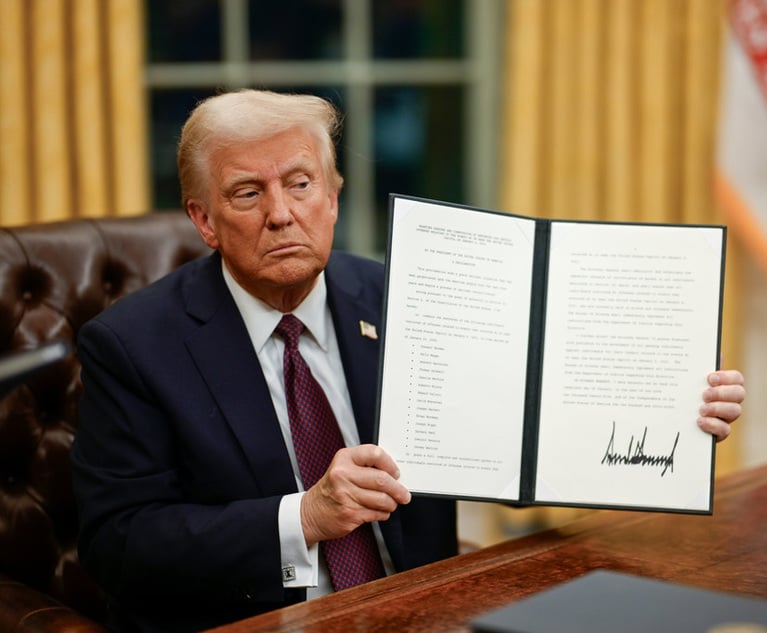Loss Causation in Securities Fraud Cases
David B. Saxe and Danielle C. Lesser discuss the First Department's review of Commercial Division cases, specifically cases addressing the issue of loss causation in the securities fraud context.
October 18, 2017 at 02:00 PM
21 minute read

Proximate cause is a vital element in negligence cases, but is also an important element in securities fraud cases, where it is known as loss causation.
The pivotal requirement of demonstrating loss causation in a securities fraud claim was the focus of a March 2017 First Department case, Basis PAC-Rim Opportunity Fund (Master) v. TCW Asset Mgmt. Co., 149 A.D.3d 146 (1st Dep't 2017), in which the plaintiff sought damages against a defendant for allegedly fraudulently inducing it to invest in risky residential mortgage-backed securities (RMBS) before the 2008 market crash. The case turned on whether loss causation exists where the defendant made material misrepresentations in the face of the catastrophic unanticipated economic conditions of the unprecedented market collapse. Prior to the appeal, the motion court (Kornreich, J.) (No. 654033/2012, 2015 N.Y. Misc. LEXIS 3703 (Oct. 16, 2015)), found that the defendant made misrepresentations to induce the plaintiff's investment and therefore should face potential legal responsibility for such misrepresentations. The Appellate Division, First Department, in a unanimous opinion authored by Associate Justice Barbara Kapnick, reversed the motion court holding that the market collapse precluded a finding of loss causation because no matter what strategy the defendant recommended, the plaintiff would have incurred losses. The First Department, therefore, granted the defendant TCW Asset Management Company's (TCW) summary judgment motion, finding that the plaintiffs, Basis Pac-Rim Opportunity Fund (Master) and Basis Yield Alpha Fund (Master) (collectively Basis), had not met their burden on the issue of loss causation.
Defendant TCW was the collateral manager of Dutch Hill Funding II (Dutch Hill), a collateralized debt obligation which paired long positions in below-grade tranches of RMBS with short positions in higher-rated tranches of the same bonds. TCW claimed to have a system for identifying which RMBS were good investments and which were poor investments by exploiting market inefficiencies to identify undervalued RMBS for Dutch Hill. Basis alleged that TCW's representations induced it to invest in Dutch Hill in May 2007, shortly before the housing market crashed causing the investment to lose all of its value, forcing it into bankruptcy. Basis's lawsuit against TCW alleged, among other things, that TCW fabricated its ability to find “good” RMBS to include in Dutch Hill and fraudulently induced Basis to invest in Dutch Hill.
In a fraud case, the plaintiff must prove: (1) a material misrepresentation of a fact; (2) knowledge of its falsity; (3) an intent to induce reliance; (4) justifiable reliance by the plaintiff; and 5) damages as a result of the misrepresentation. Basis, 2015 N.Y. Misc. LEXIS 3703, at * 18 (quoting Eurycleia Partners, LP v. Seward & Kissel, LLP, 12 N.Y.3d 553, 559 (2009)). The damages must be actual damages in order to satisfy the damage element of a claim for fraud. Connaughton v. Chipotle Mexican Grill, 29 N.Y.3d 137, 143-44 (2017)
To prevail in a securities fraud claim, the plaintiff must prove both transaction causation and loss causation. To establish transaction causation, the “plaintiff must show … that defendant's misrepresentation induced plaintiff to engage in the transaction in question.” Basis, 2015 N.Y. Misc. LEXIS 3707, at 37 (quoting Laub v. Faessel, 297 A.D.2d 28, 31, 745 N.Y.S.2d 534 (1st Dep't 2002)). To establish loss causation, the plaintiff must show that “the misrepresentations directly caused the loss about which plaintiff complains.” Id.
Transaction causation was not at issue in Basis. However, the issue of loss causation was vigorously contested, despite the common proposition that “questions of proximate cause … should generally be resolved by the factfinder.” Voss v. The Netherlands Ins. Co., 22 N.Y.3d 728, 737 (2014).
In her decision, Justice Kornreich stated that she was guided by Loreley Fin. No. 3 Ltd. v. Wells Fargo Sec., 797 F.3d 160 (2d Cir. 2015) (Wells Fargo), an RMBS fraud case, in which the court, in an opinion written by Judge Guido Calabresi explained that “[l]oss causation is lacking unless the fraudulent statement that induced her to invest can also be shown to have made her investment, in fact, more disposed to suffer the alleged harm—a catastrophic market collapse—than honestly described alternative investments.” Wells Fargo, 797 F.3d at 186. The court further stated that if “the subsequent market crash was of such dramatic proportions that plaintiffs' losses would have occurred at the same time and to the same extent regardless of the alleged fraud … and the alleged fraud in no way increased the chance of Plaintiffs' ultimate losses, then loss causation is lacking.” Wells Fargo, 797 F.3d at 186-87. (It is also worth noting that in 2013, Justice Kornreich granted a motion to dismiss in a different RMBS case on the grounds that the plaintiff had not adequately pleaded loss causation because it was the crash of the housing market in general, and not the defendants' alleged misrepresentations, that caused the losses. Loreley Financing (Jersey) No. 4 Ltd. v. UBS, 42 Misc. 3d 858, 978 N.Y.S.2d 615 (Sup. Ct. N.Y. Cty. 2013).)
In Basis, the motion court came to a different conclusion, denying TCW's motion for summary judgment and disagreeing with TCW's argument that the market crash was an unforeseen event that caused Basis's loss, which was not made more likely by TCW's misrepresentations. The motion court explained that what TCW offered was precisely its ability to navigate the risky RMBS market and that lying about this ability led to the plaintiffs' losses. Basis, 2015 N.Y. Misc. LEXIS 3707 at *45.
The motion court further explained that:
there was no suitable collateral in existence that could be used for the purpose of successfully executing TCW's investment strategy. TCW allegedly knew this to be true, but nonetheless bought inadequate RMBS collateral anyway so Basis would invest and the deal would close. This makes the loss causation question somewhat straightforward. If a jury finds that this occurred, then Basis' loss would certainly have been caused by TCW's misrepresentations since the loss would have occurred by virtue of the fact that Basis' money was invested in a strategy it was not signing up for, i.e., the zone of risk Basis sought to avoid by investing with TCW. Basis avers that it did not simply want to invest in risky RMBS, but that it wanted a certain type of exposure to risky RMBS—that is, exposure to risky RMBS selected by a trusted collateral manager who supposedly believed in its own methods.
Id. at *49-50 (emphasis in original).
On appeal, the First Department disagreed. It explained that:
when the plaintiff's loss coincides with a marketwide phenomenon causing comparable losses to other investors, the prospect that the plaintiff's loss was caused by the fraud decreases, and a plaintiff's claim fails when it has not proven that its loss was caused by the alleged misstatements as opposed to intervening events. Indeed, when an investor suffers an investment loss due to a market crash of such dramatic proportions that the losses would have occurred at the same time and to the same extent regardless of the alleged fraud, loss causation is lacking.
149 A.D.3d at 149 (internal citations, quotation marks, brackets, and ellipses omitted).
The First Department found that TCW “proffered evidence that Dutch Hill would have collapsed regardless of the assets selected by TCW due to the housing market crash.” Id. at 150. TCW's expert “opined that even if TCW had selected assets that complied with the Dutch Hill model and comported with TCW's representations to Basis, Basis would still have suffered a loss due to an external and intervening cause—namely, the housing market crash.” Id. In response, Basis “failed to produce any evidence that under the circumstances here involving the collapse of the RMBS market, it was TCW's misrepresentations, rather than market forces, that caused the investment losses.” Id.
In concluding that Basis could not establish loss causation, the First Department cautioned that “[w]e do not mean to suggest that all cases in which a plaintiff alleges fraud will be unable to survive summary judgment in the event of a market collapse. However, in this case, it is Basis's complete failure to meet its burden on the issue of loss causation that compels our decision.” Id. at 151.
In finding that loss causation was established, the Motion Court pointed out that “[s]ince TCW's investment strategy was premised on navigating an admittedly problematic RMBS market, lying about navigating the market in the manner advertised would surely be causally related to Basis' loss, as Basis having its money invested in knowingly troublesome RMBS was precisely the risk Basis sought to avoid by investing with TCW.” 2015 N.Y. Misc. LEXIS 3703, at *45. The First Department observed, however, that Basis could not produce evidence that “it was TCW's misrepresentations, rather than market forces, that caused the investment losses.” 149 A.D.3d at 150. In this case, the First Department viewed the market forces as nullifying the misrepresentations, and concluded that Basis could not establish loss causation.
It is noteworthy that the parties focused their legal argument solely on the issue of loss causation. Neither party addressed the issue of damages in its analysis. A possible alternative legal theory might have been whether TCW's false representations of its expertise in selecting less risky RMBS securities established loss causation but Basis, as the proponent of the fraud claim, could not demonstrate damages because of the market collapse. Had the courts examined the controversy through the prism of the availability of damages, such analysis might have offered an interesting alternate theory to loss causation. Regardless, it is clear that the issue of loss causation is one that is pivotal in the securities fraud context and one which the Court of Appeals might consider addressing in the future.
David B. Saxe is a former Associate Justice of the Appellate Division, First Department where he served for 19 years before becoming a partner at Morrison Cohen. Danielle C. Lesser is also a partner at the firm, where she is co‑chair of the business litigation group. Associate Michael Mix assisted in the preparation of this article.

Proximate cause is a vital element in negligence cases, but is also an important element in securities fraud cases, where it is known as loss causation.
The pivotal requirement of demonstrating loss causation in a securities fraud claim was the focus of a March 2017
Defendant TCW was the collateral manager of Dutch Hill Funding II (Dutch Hill), a collateralized debt obligation which paired long positions in below-grade tranches of RMBS with short positions in higher-rated tranches of the same bonds. TCW claimed to have a system for identifying which RMBS were good investments and which were poor investments by exploiting market inefficiencies to identify undervalued RMBS for Dutch Hill. Basis alleged that TCW's representations induced it to invest in Dutch Hill in May 2007, shortly before the housing market crashed causing the investment to lose all of its value, forcing it into bankruptcy. Basis's lawsuit against TCW alleged, among other things, that TCW fabricated its ability to find “good” RMBS to include in Dutch Hill and fraudulently induced Basis to invest in Dutch Hill.
In a fraud case, the plaintiff must prove: (1) a material misrepresentation of a fact; (2) knowledge of its falsity; (3) an intent to induce reliance; (4) justifiable reliance by the plaintiff; and 5) damages as a result of the misrepresentation. Basis, 2015 N.Y. Misc. LEXIS 3703, at * 18 (quoting
To prevail in a securities fraud claim, the plaintiff must prove both transaction causation and loss causation. To establish transaction causation, the “plaintiff must show … that defendant's misrepresentation induced plaintiff to engage in the transaction in question.” Basis, 2015 N.Y. Misc. LEXIS 3707, at 37 (quoting
Transaction causation was not at issue in Basis. However, the issue of loss causation was vigorously contested, despite the common proposition that “questions of proximate cause … should generally be resolved by the factfinder.”
In her decision, Justice Kornreich stated that she was guided by
In Basis, the motion court came to a different conclusion, denying TCW's motion for summary judgment and disagreeing with TCW's argument that the market crash was an unforeseen event that caused Basis's loss, which was not made more likely by TCW's misrepresentations. The motion court explained that what TCW offered was precisely its ability to navigate the risky RMBS market and that lying about this ability led to the plaintiffs' losses. Basis, 2015 N.Y. Misc. LEXIS 3707 at *45.
The motion court further explained that:
there was no suitable collateral in existence that could be used for the purpose of successfully executing TCW's investment strategy. TCW allegedly knew this to be true, but nonetheless bought inadequate RMBS collateral anyway so Basis would invest and the deal would close. This makes the loss causation question somewhat straightforward. If a jury finds that this occurred, then Basis' loss would certainly have been caused by TCW's misrepresentations since the loss would have occurred by virtue of the fact that Basis' money was invested in a strategy it was not signing up for, i.e., the zone of risk Basis sought to avoid by investing with TCW. Basis avers that it did not simply want to invest in risky RMBS, but that it wanted a certain type of exposure to risky RMBS—that is, exposure to risky RMBS selected by a trusted collateral manager who supposedly believed in its own methods.
Id. at *49-50 (emphasis in original).
On appeal, the First Department disagreed. It explained that:
when the plaintiff's loss coincides with a marketwide phenomenon causing comparable losses to other investors, the prospect that the plaintiff's loss was caused by the fraud decreases, and a plaintiff's claim fails when it has not proven that its loss was caused by the alleged misstatements as opposed to intervening events. Indeed, when an investor suffers an investment loss due to a market crash of such dramatic proportions that the losses would have occurred at the same time and to the same extent regardless of the alleged fraud, loss causation is lacking.
149 A.D.3d at 149 (internal citations, quotation marks, brackets, and ellipses omitted).
The First Department found that TCW “proffered evidence that Dutch Hill would have collapsed regardless of the assets selected by TCW due to the housing market crash.” Id. at 150. TCW's expert “opined that even if TCW had selected assets that complied with the Dutch Hill model and comported with TCW's representations to Basis, Basis would still have suffered a loss due to an external and intervening cause—namely, the housing market crash.” Id. In response, Basis “failed to produce any evidence that under the circumstances here involving the collapse of the RMBS market, it was TCW's misrepresentations, rather than market forces, that caused the investment losses.” Id.
In concluding that Basis could not establish loss causation, the First Department cautioned that “[w]e do not mean to suggest that all cases in which a plaintiff alleges fraud will be unable to survive summary judgment in the event of a market collapse. However, in this case, it is Basis's complete failure to meet its burden on the issue of loss causation that compels our decision.” Id. at 151.
In finding that loss causation was established, the Motion Court pointed out that “[s]ince TCW's investment strategy was premised on navigating an admittedly problematic RMBS market, lying about navigating the market in the manner advertised would surely be causally related to Basis' loss, as Basis having its money invested in knowingly troublesome RMBS was precisely the risk Basis sought to avoid by investing with TCW.” 2015 N.Y. Misc. LEXIS 3703, at *45. The First Department observed, however, that Basis could not produce evidence that “it was TCW's misrepresentations, rather than market forces, that caused the investment losses.” 149 A.D.3d at 150. In this case, the First Department viewed the market forces as nullifying the misrepresentations, and concluded that Basis could not establish loss causation.
It is noteworthy that the parties focused their legal argument solely on the issue of loss causation. Neither party addressed the issue of damages in its analysis. A possible alternative legal theory might have been whether TCW's false representations of its expertise in selecting less risky RMBS securities established loss causation but Basis, as the proponent of the fraud claim, could not demonstrate damages because of the market collapse. Had the courts examined the controversy through the prism of the availability of damages, such analysis might have offered an interesting alternate theory to loss causation. Regardless, it is clear that the issue of loss causation is one that is pivotal in the securities fraud context and one which the Court of Appeals might consider addressing in the future.
David B. Saxe is a former Associate Justice of the Appellate Division, First Department where he served for 19 years before becoming a partner at
This content has been archived. It is available through our partners, LexisNexis® and Bloomberg Law.
To view this content, please continue to their sites.
Not a Lexis Subscriber?
Subscribe Now
Not a Bloomberg Law Subscriber?
Subscribe Now
NOT FOR REPRINT
© 2025 ALM Global, LLC, All Rights Reserved. Request academic re-use from www.copyright.com. All other uses, submit a request to [email protected]. For more information visit Asset & Logo Licensing.
You Might Like
View All
'A Shock to the System’: Some Government Attorneys Are Forced Out, While Others Weigh Job Options
7 minute read
'Serious Legal Errors'?: Rival League May Appeal Following Dismissal of Soccer Antitrust Case
6 minute read
How Some Elite Law Firms Are Growing Equity Partner Ranks Faster Than Others
4 minute read
Trending Stories
- 1Ex-Starbucks GC Exiting Latest Role, Will Get Severance
- 2Family Law Special Section 2025
- 3We Must Uphold the Rights of Immigrant Students
- 4Orrick Picks Up 13-Lawyer Tech, VC Group From Gunderson Dettmer
- 5How Alzheimer’s and Other Cognitive Diseases Affect Guardianship, POAs and Estate Planning
Who Got The Work
J. Brugh Lower of Gibbons has entered an appearance for industrial equipment supplier Devco Corporation in a pending trademark infringement lawsuit. The suit, accusing the defendant of selling knock-off Graco products, was filed Dec. 18 in New Jersey District Court by Rivkin Radler on behalf of Graco Inc. and Graco Minnesota. The case, assigned to U.S. District Judge Zahid N. Quraishi, is 3:24-cv-11294, Graco Inc. et al v. Devco Corporation.
Who Got The Work
Rebecca Maller-Stein and Kent A. Yalowitz of Arnold & Porter Kaye Scholer have entered their appearances for Hanaco Venture Capital and its executives, Lior Prosor and David Frankel, in a pending securities lawsuit. The action, filed on Dec. 24 in New York Southern District Court by Zell, Aron & Co. on behalf of Goldeneye Advisors, accuses the defendants of negligently and fraudulently managing the plaintiff's $1 million investment. The case, assigned to U.S. District Judge Vernon S. Broderick, is 1:24-cv-09918, Goldeneye Advisors, LLC v. Hanaco Venture Capital, Ltd. et al.
Who Got The Work
Attorneys from A&O Shearman has stepped in as defense counsel for Toronto-Dominion Bank and other defendants in a pending securities class action. The suit, filed Dec. 11 in New York Southern District Court by Bleichmar Fonti & Auld, accuses the defendants of concealing the bank's 'pervasive' deficiencies in regards to its compliance with the Bank Secrecy Act and the quality of its anti-money laundering controls. The case, assigned to U.S. District Judge Arun Subramanian, is 1:24-cv-09445, Gonzalez v. The Toronto-Dominion Bank et al.
Who Got The Work
Crown Castle International, a Pennsylvania company providing shared communications infrastructure, has turned to Luke D. Wolf of Gordon Rees Scully Mansukhani to fend off a pending breach-of-contract lawsuit. The court action, filed Nov. 25 in Michigan Eastern District Court by Hooper Hathaway PC on behalf of The Town Residences LLC, accuses Crown Castle of failing to transfer approximately $30,000 in utility payments from T-Mobile in breach of a roof-top lease and assignment agreement. The case, assigned to U.S. District Judge Susan K. Declercq, is 2:24-cv-13131, The Town Residences LLC v. T-Mobile US, Inc. et al.
Who Got The Work
Wilfred P. Coronato and Daniel M. Schwartz of McCarter & English have stepped in as defense counsel to Electrolux Home Products Inc. in a pending product liability lawsuit. The court action, filed Nov. 26 in New York Eastern District Court by Poulos Lopiccolo PC and Nagel Rice LLP on behalf of David Stern, alleges that the defendant's refrigerators’ drawers and shelving repeatedly break and fall apart within months after purchase. The case, assigned to U.S. District Judge Joan M. Azrack, is 2:24-cv-08204, Stern v. Electrolux Home Products, Inc.
Featured Firms
Law Offices of Gary Martin Hays & Associates, P.C.
(470) 294-1674
Law Offices of Mark E. Salomone
(857) 444-6468
Smith & Hassler
(713) 739-1250






